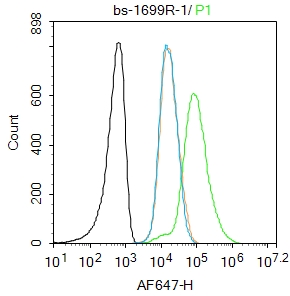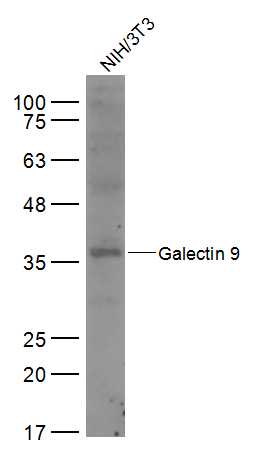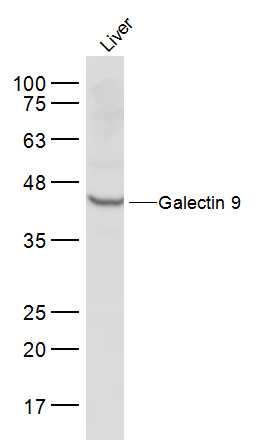Galectin 9 Rabbit pAb
Galectin 9 Rabbit pAb
- 产品详情
- 实验流程
- 背景知识
Application
| WB |
|---|---|
| Primary Accession | O08573 |
| Reactivity | Mouse |
| Host | Rabbit |
| Clonality | Polyclonal |
| Calculated MW | 40036 Da |
| Physical State | Liquid |
| Immunogen | KLH conjugated synthetic peptide derived from mouse Galectin |
| Epitope Specificity | 51-150/353 |
| Isotype | IgG |
| Purity | affinity purified by Protein A |
| Buffer | 0.01M TBS (pH7.4) with 1% BSA, 0.02% Proclin300 and 50% Glycerol. |
| SUBCELLULAR LOCATION | Cytoplasm. Secreted. Note=May also be secreted by a non-classical secretory pathway. |
| SIMILARITY | Contains 2 galectin domains. |
| SUBUNIT | Homodimer. |
| Important Note | This product as supplied is intended for research use only, not for use in human, therapeutic or diagnostic applications. |
| Background Descriptions | Binds galactosides. May play a role in thymocyte-epithelial interactions relevant to the biology of the thymus. Is a ligand for HAVCR2/TIM3. Induces T-helper type 1 lymphocyte (Th1) death (By similarity). May provide the molecular basis for urate flux across cell membranes, allowing urate that is formed during purine metabolism to efflux from cells and serving as an electrogenic transporter that plays an important role in renal and gastrointestinal urate excretion. Highly selective to the anion urate. |
| Gene ID | 16859 |
|---|---|
| Other Names | Galectin-9, Gal-9, Lgals9 |
| Target/Specificity | Accentuated expression in liver and thymus of embryo, detected in embryonic heart, brain, lung, liver, and kidney. Highly expressed in adult thymus, small intestine, and liver, and to a lesser extent in lung, kidney, spleen, cardiac, and skeletal muscle. Barely detectable in brain and reticulocyte. The isoform Long is expressed exclusively in the small intestine. |
| Dilution | WB=1:500-2000,Flow-Cyt=1ug/Test |
| Format | 0.01M TBS(pH7.4) with 1% BSA, 0.09% (W/V) sodium azide and 50% Glyce |
| Storage | Store at -20 °C for one year. Avoid repeated freeze/thaw cycles. When reconstituted in sterile pH 7.4 0.01M PBS or diluent of antibody the antibody is stable for at least two weeks at 2-4 °C. |
| Name | Lgals9 |
|---|---|
| Function | Binds galactosides (By similarity). Has high affinity for the Forssman pentasaccharide (By similarity). Ligand for HAVCR2/TIM3 (By similarity). Binding to HAVCR2 induces T-helper type 1 lymphocyte (Th1) death (By similarity). Also stimulates bactericidal activity in infected macrophages by causing macrophage activation and IL1B secretion which restricts intracellular bacterial growth (PubMed:20937702). Ligand for P4HB; the interaction retains P4HB at the cell surface of Th2 T-helper cells, increasing disulfide reductase activity at the plasma membrane, altering the plasma membrane redox state and enhancing cell migration (PubMed:21670307). Ligand for CD44; the interaction enhances binding of SMAD3 to the FOXP3 promoter, leading to up-regulation of FOXP3 expression and increased induced regulatory T (iTreg) cell stability and suppressive function (PubMed:25065622). Promotes ability of mesenchymal stromal cells to suppress T-cell proliferation (By similarity). Expands regulatory T- cells and induces cytotoxic T-cell apoptosis following virus infection (By similarity). Activates ERK1/2 phosphorylation inducing cytokine (IL-6, IL-8, IL-12) and chemokine (CCL2) production in mast and dendritic cells (By similarity). Inhibits degranulation and induces apoptosis of mast cells (By similarity). Induces maturation and migration of dendritic cells (By similarity). Inhibits natural killer (NK) cell function (PubMed:23408620). Can transform NK cell phenotype from peripheral to decidual during pregnancy (By similarity). Astrocyte derived galectin-9 enhances microglial TNF production (PubMed:25158758). May play a role in thymocyte-epithelial interactions relevant to the biology of the thymus. May provide the molecular basis for urate flux across cell membranes, allowing urate that is formed during purine metabolism to efflux from cells and serving as an electrogenic transporter that plays an important role in renal and gastrointestinal urate excretion (By similarity). Highly selective to the anion urate (By similarity). |
| Cellular Location | Cytoplasm. Nucleus. Secreted {ECO:0000250|UniProtKB:O00182} Note=May also be secreted by a non-classical secretory pathway (PubMed:9038233). Secreted by mesenchymal stromal cells upon IFNG stimulation (By similarity). {ECO:0000250|UniProtKB:O00182, ECO:0000269|PubMed:9038233} |
| Tissue Location | Accentuated expression in liver and thymus of embryo, detected in embryonic heart, brain, lung, liver, and kidney Highly expressed in adult thymus, small intestine, and liver, and to a lesser extent in lung, kidney, spleen, cardiac, and skeletal muscle Barely detectable in brain and reticulocyte. Expressed in placenta, uterus and decidua during pregnancy (PubMed:23242525). Expressed in CD4+ T-cells with higher levels in iTreg cells than other T-cell types and sustained high levels throughout iTreg cell differentiation (at protein level) (PubMed:25065622). Expressed in myeloid cells in lung (PubMed:20937702). Constitutively expressed in microglia (PubMed:25158758). Isoform 1 is expressed exclusively in the small intestine. Isoform 2 expression in decidua increases in pathological pregnancy from gestation day 7.5 to 13.5 and it is higher than in normal pregnancy (PubMed:23242525). Isoform 3 expression in decidua is higher in normal pregnancy than in pathological pregnancy (PubMed:23242525). |
Research Areas
For Research Use Only. Not For Use In Diagnostic Procedures.
Application Protocols
Provided below are standard protocols that you may find useful for product applications.
BACKGROUND
This product as supplied is intended for research use only, not for use in human, therapeutic or diagnostic applications.
终于等到您。ABCEPTA(百远生物)抗体产品。
点击下方“我要评价 ”按钮提交您的反馈信息,您的反馈和评价是我们最宝贵的财富之一,
我们将在1-3个工作日内处理您的反馈信息。
如有疑问,联系:0512-88856768 tech-china@abcepta.com.
¥ 1,500.00
Cat# AP94113























 癌症的基本特征包括细胞增殖、血管生成、迁移、凋亡逃避机制和细胞永生等。找到癌症发生过程中这些通路的关键标记物和对应的抗体用于检测至关重要。
癌症的基本特征包括细胞增殖、血管生成、迁移、凋亡逃避机制和细胞永生等。找到癌症发生过程中这些通路的关键标记物和对应的抗体用于检测至关重要。 为您推荐一个泛素化位点预测神器——泛素化分析工具,可以为您的蛋白的泛素化位点作出预测和评分。
为您推荐一个泛素化位点预测神器——泛素化分析工具,可以为您的蛋白的泛素化位点作出预测和评分。 细胞自噬受体图形绘图工具为你的蛋白的细胞受体结合位点作出预测和评分,识别结合到自噬通路中的蛋白是非常重要的,便于让我们理解自噬在正常生理、病理过程中的作用,如发育、细胞分化、神经退化性疾病、压力条件下、感染和癌症。
细胞自噬受体图形绘图工具为你的蛋白的细胞受体结合位点作出预测和评分,识别结合到自噬通路中的蛋白是非常重要的,便于让我们理解自噬在正常生理、病理过程中的作用,如发育、细胞分化、神经退化性疾病、压力条件下、感染和癌症。








